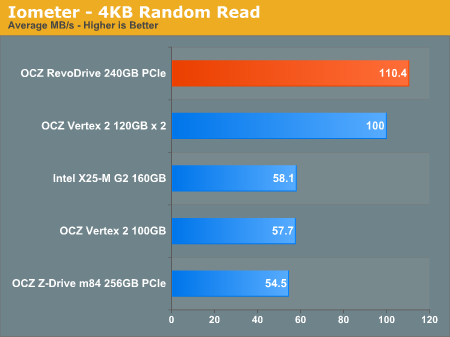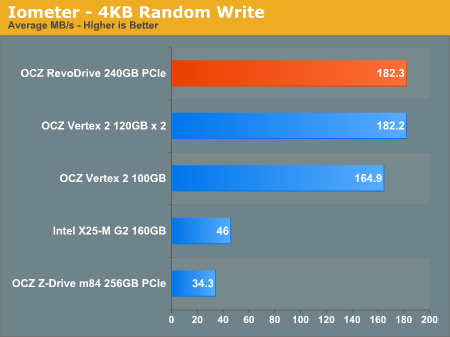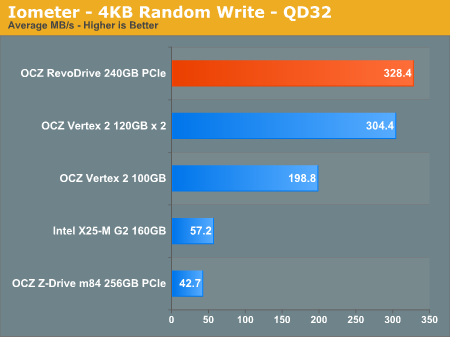OCZ's RevoDrive Preview: An Affordable PCIe SSD
by Anand Lal Shimpi on June 25, 2010 2:15 AM ESTRandom Read/Write Speed
This test reads/writes 4KB in a completely random pattern over an 8GB space of the drive to simulate the sort of random access that you'd see on an OS drive (even this is more stressful than a normal desktop user would see). I perform three concurrent IOs and run the test for 3 minutes. The results reported are in average MB/s over the entire time. All requests are 4KB aligned.

Compared to a single Vertex 2, the RevoDrive is nearly twice the performance. The Revo actually outperforms our two Vertex 2s in RAID-0 thanks to the controller on the card. This is more the exception rather than the rule however, Intel’s ICH10R is one of the fastest desktop SATA 3Gbps controllers we’ve ever seen.

At low queue depths random write performance doesn’t actually improve that much. A single Vertex 2 SSD is already running at close to peak performance here. Compared to last year’s more expensive Z-Drive m84 the performance improvement is tremendous.
Crank up the queue depth for a particularly intensive workload and you’ll see the RevoDrive separate itself from a single drive:

At over 300MB/s there’s no single SATA 3Gbps drive that could deliver this sort of performance. And honestly it’s in these high queue depth scenarios that the RevoDrive really shines. The majority of desktop users simply aren’t pushing this many IOs at a given time, but if you are the Revo won’t disappoint. A pair of Vertex 2s in RAID-0 won’t either. It all comes down to cost and preference.










62 Comments
View All Comments
nurd - Saturday, June 26, 2010 - link
The SiI 3124 is just a standard SATA controller; the RAID is software.And not everybody uses drivers written by Silicon Image, or for Windows :)
Nomgle - Monday, July 5, 2010 - link
Erm, that's completely wrong - i suggest you read this review again, and pay careful attention to the RAID-setup screenshots...The Silicon Image 3124 used on this card, IS a RAID controller, and does require drivers.
vol7ron - Friday, June 25, 2010 - link
"The PCIe x8 card was made up of four Indilinx barefoot controllers configured in RAID-0, delivering up to four times the performance of a single Indilinx SSD but on a single card."Is this something that you witnessed?
When you have 4 channels of RAID-0, I thought the performance was more exponential. 2 drives/memory chips in parallel may be twice the performance, but 3 drives would be more like 4+ times times the performance.
I think having the daughter board would really change things.
Also, doesn't Intel have a TRIM driver for their RAID controller?
vol7ron
Mr Perfect - Friday, June 25, 2010 - link
It should be linear growth, minus overhead.Performance would have to be additive. Three drives can't be four times the performance of one drive. If one drive achieves 55.7MB/s, then you could theoretically get 55.7x3=167.1MB/s from three or 55.7x4=222.8MB/s from four. Considering each drive will only ever be able to put out 55.7MB/s, then how could three achieve 222.8 total? Dividing the 222.8MB/s by 3 would give you 74.2 MB/s output from each drive, when they are physically only capable of 55.7MB/s each. The math would get even wonkier as you scaled higher up the exponential curve.
kmmatney - Friday, June 25, 2010 - link
You really need to include SSDs and hard drives in the Benchmarks feature of this website. It would really help for people upgrading from older drives, such as first gen drives, or other drives that you wouldn't be able to inlucde in teh benchamrks for every single review.knowom - Friday, June 25, 2010 - link
I'm still waiting on a modern I-Ram priced reasonably with PCI-E bandwidth with a flash card slot for data retention preferably accessible from the PCI-E retention bracket for convenient access and ability to make it hot swappable and DDR3 dimm slots angled diagonally so you could fit more dimm slots and the manufacturer could fit more easily by elongating the PCB like with video cards as well.How a modern I-Ram device would be done ideally
except angled more optimally for capacity in mind
---------------------------------------------------------------------
| | dimm slots |
| Flash | / / / / / / / / |
| | / / / / / / / / |
| ---------------- / / / / / / / / |
| / / / / / / / / |
| PCI-E / / / / / / / / |
--------__________-------------------------------------------
iwodo - Saturday, June 26, 2010 - link
Until SandForce SATA 3.0 version of Controller comes out. It will be faster then Revo.The Next Mile Stone is 1GB/s, while making it stays the same price........
sunshine - Saturday, June 26, 2010 - link
Regarding the 64GB Crucial RealSSD C300:This 64 GB version of this SSD, has a much slower write speed than the 256 GB version.
Write speeds vary with capacity:
70MB/s for the 64GB model, 140MB for 128GB and 215MB/s for the 256GB.
So apparently there is a trade off, lower price, but lower speed as well.
lukeevanssi - Saturday, June 26, 2010 - link
I am thinking of buying a E-revo 1/16 scale. I was wondering how well does this truck drive on grass if i put dual battery packs on it?. Can it climb well on dirt mounds? Thanksif anybody want to know more about it so plz visit this link:-
http://www.healthproductreviewers.com/force-factor...
there is a lot off knowledge about this product
529th - Saturday, June 26, 2010 - link
My Vertex LE died about 2 weeks ago.